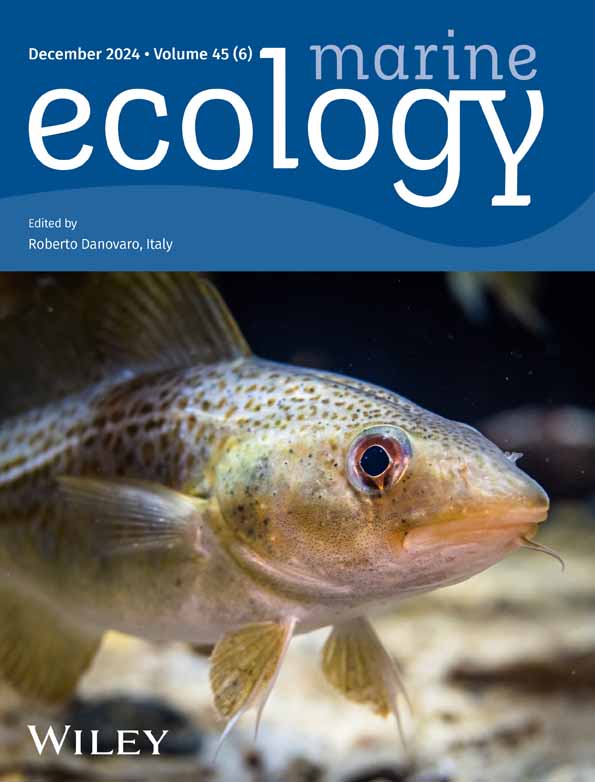Multi-year monitoring shows higher species richness and diversity of fish assemblages in a Danish seagrass meadow as compared to neighbouring non-vegetated areas
Abstract
Seagrass meadows provide an important nursery and feeding habitat for fish, globally. However, limited data exist on how these vegetated coastal ecosystems affect local fish stocks over longer time periods. By means of beach seine hauling with a bio-monitoring seine net, we collected fish data in Kronborg Bay (Denmark) over 4 years. The bay contains both vegetated and bare sediment areas in close proximity to Kronborg Castle in Elsinore and is part of the Øresund strait; a dynamic marine environment linking the Baltic Sea with the inner Danish waters (Kattegat). We investigated the biodiversity and fish abundance in a healthy seagrass meadow and compared it with a bare adjacent sediment area. We show that seagrass is important for fish species like the Atlantic cod, the two-spotted goby, and the broadnosed pipefish. The seagrass meadow harboured more fish species and higher biodiversity, while the number of individuals was higher in the adjacent bare sediment area as a result of high abundances of lesser sand eel. Pilou's evenness and the Shannon-Wiener index showed 2–4-fold higher biodiversity in the seagrass meadow. The seagrass meadow harboured about 35% more fish species than the bare adjacent sediment. The Atlantic cod was almost entirely found in the seagrass meadow, while lesser sand eel that showed an overall increase in abundance in both habitats, represented the largest proportion of the total number of fish individuals (up to about 60%) and was mostly found on the bare adjacent sediment. Species abundance was analysed for changes over time, where, for example the European plaice showed an increase in abundance over the 4-year period of investigation. Seagrass meadows can thus be very important for the Atlantic cod population in the Øresund strait and generally for local fish productivity, abundance and diversity.
1 INTRODUCTION
Seagrass meadows in Denmark mainly consist of eelgrass (Zostera marina L.), which is widespread in the inner Danish waters and fjords, where it thrives in brackish to full salinity waters and exhibits a high tolerance for changing temperature and salinity conditions (Hansen & Høgslund, 2021; Pihl et al., 2006). Eelgrass and other seagrasses provide important ecosystem services such as mitigating coastal erosion (Fonseca & Cahalan, 1992) and global warming via effective carbon sequestration (Duarte et al., 2005; Duarte & Krause-Jensen, 2017; Fourqurean et al., 2012; Leiva-Dueñas et al., 2023; Macreadie et al., 2021). However, seagrass meadows are also recognized for their huge beneficial and economic effects on fish stocks all over the globe (Bertelli & Unsworth, 2014; Unsworth, Nordlund, et al., 2019).
Seagrasses serve as a refugium, feeding ground and nursery habitat in coastal waters for a wide variety of invertebrate and vertebrate marine species (Colvin & Snelgrove, 2023; Unsworth, McKenzie, et al., 2019; Unsworth, Nordlund, et al., 2019; York et al., 2006), which includes fish populations like the juvenile Atlantic cod (Gadus morhua) and many other fish species with a more or less direct influence on fisheries productivity (Bertelli & Unsworth, 2014; Stål et al., 2008). This ecosystem service can largely be explained by: (i) higher growth and feeding rates; (ii) lower energy requirements and (iii) reduced predation in many species of juvenile fish inhabiting seagrass meadows, as compared with fish residing in other coastal habitats (Bertelli & Unsworth, 2014). The complex three-dimensional habitat structure of seagrass meadows thus supports a plethora of species, especially during early life stages (Jones et al., 2021), where the seagrass habitat represents an important spawning ground and hideout for many juvenile fish (Smith et al., 2008, 2011). Seagrass meadows can therefore increase fisheries productivity and aid to meet the growing demand for feeding human populations (Bertelli & Unsworth, 2014). However, animals like crustaceans, fish and snails, also serve various important roles for the seagrass plants such, as grazing on leaf epiphytes (Emmett Duffy et al., 2003), thereby reducing the negative effects of epiphyte overgrowth on leaves, such as shading (Brodersen et al., 2015; Noisette et al., 2020) and limiting nutrient and gas exchange with the water column due to extended diffusive pathways around leaves and epiphyte activity/consumption (Brodersen et al., 2020; Brodersen & Kühl, 2022; Zhang et al., 2022). Bare sediment is a more uniform habitat that harbours species with special adaptations to life in these conditions, including infauna and burrowing species of fish (Henseler et al., 2019). Water flow conditions, oxygen levels and what fish species are found depend strongly on the composition of the sediment, where grain size can be an important niche-shaping factor (Giakoumi & Kokkoris, 2013).
Seagrass meadows are also recognized for supporting high marine biodiversity in coastal regions (Unsworth & Cullen-Unsworth, 2017; Unsworth, McKenzie, et al., 2019; Unsworth, Nordlund, et al., 2019). Limited data exists, however, on how seagrass meadows affect fish diversity, abundance and populations in Danish waters (especially in recent years where studies of fish diversity are limited; hence, some of the most detailed studies date back to, for example Rasmussen, 1973) and more generally, how changing environmental conditions, like temperature, light, air saturation and salinity, affect the beneficial role of the meadows as compared with bare sediment areas. In addition, the Atlantic cod (G. morhua), until recently, thought to have high abundance in the western Baltic Sea in comparison to the surrounding areas, has now declined, making seagrasses role as nursery habitat for this fish species even more important (e.g., Baden et al., 2012; Boström et al., 2014; Timmermann et al., 2023). Such a decrease in larger predatory fish (e.g., the Atlantic cod) can result in an increased proportion of smaller predator fish species (e.g., the two-spotted goby Gobiusculus flavescens), potentially causing cascading trophic level effects that may detrimentally impact the functioning of coastal habitats such as seagrass meadows (Baden et al., 2012). The aim of this study was therefore to determine the role and importance of seagrass meadows for the fish abundance and diversity in Danish waters, with a focus on commercially important species like the Atlantic cod (G. morhua). We investigated whether a selected Danish seagrass meadow has higher species richness and fish diversity than adjacent bare sediment. We also examined whether the seagrass meadow represents an important habitat for a range of key species of value for commercial fisheries, including the Atlantic cod (G. morhua) and the lesser sand eel (Ammodytes tobianus) (Green, 2017; Lilley & Unsworth, 2014). We hypothesized that the seagrass meadow would have higher fish species richness and diversity than the adjacent bare sediment habitat.
2 MATERIALS AND METHODS
2.1 Sampling site and water-column conditions
Fish sampling was carried out in shallow water (<5 m) in the northeastern part of Zealand, Denmark, within a small, saline (salinity of ~15) bay called Kronborg Bay (Figure 1), which is situated between Kronborg Castle and the marina in Helsingør/Elsinore in the northern part of Øresund (North Zealand, Denmark). The bay harbours a healthy seagrass bed and adjacent bare sand areas, where we have collected fish over a 4-year period (2017–2020). The seagrass meadow consists of Z. marina L. specimens that grow in dense but scattered patches mainly in the middle of the bay (as shown in Figure 1c). The adjacent sediment is dominated by bare sand. The bay is connected to the Øresund strait and is part of a large estuarine system connecting the brackish Baltic Sea to oceanic waters from the North Sea. Trawling has been banned in Øresund since the early 1930's, which provides some protection to the fish stocks in the area (Sørensen et al., 2016). The water column of the site was characterized by CTD profiling (Seabird, SBE 25plus Sealogger CTD; Sea-Bird Scientific, Washington, United States) during sampling. This was done by lowering the CTD from a small boat, while continuously measuring and recording data, including water temperature, salinity, oxygen saturation, raw fluorescence, and PAR irradiance (400–700 nm) with depth.
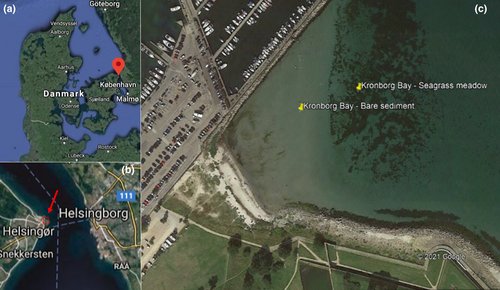
2.2 Fish sampling over seagrass and bare sediment areas
A seine net was used for catching fish (Figure 2), and data were collected from 2017 to 2020 during April–October, when eelgrass is most productive and where the 3D structure of the seagrass meadow thus diverges the most from the adjacent bare sediment (Wium-Andersen & Borum, 1984). A total of 64 seine hauls were performed, yielding 32 hauls within each sampling area (sample frequency of ~9 hauls year−1); always performed on the same day of year and location. However, because of the COVID-19 pandemic, no fish sampling was performed in the early part of 2020, where we missed some of the productive season.

Seine hauling is a traditional form of fishing, that remains the most effective method for coastal fish surveys in shallow and often turbid water (Bertelli & Unsworth, 2014), and is useful for studying fish diversity and abundance in seagrass meadows (Crane & Kapuscinski, 2018). The nets (8 m long, 0.75 m high and ≤10 mm mesh size) were deployed to water depths of about 1.5 m and then hauled to shore by hand and emptied out in tubs, buckets and trays. The length of the haul (in m) was noted for both habitats and used to calculate the sampling area in m2. Both the seagrass haul and the haul on adjacent bare sediment were done around noon, with a couple of hours interval in between (alternating between which sampling area was sampled first). Animals collected from the seagrass meadow and the adjacent bare sediment were subsequently sorted out and identified in a nearby wet lab facility (Marine Biological Section, University of Copenhagen, Helsingør, Denmark), where the caught fish were retained between seine hauls to avoid catching the same fish twice. Catches from both coastal habitats included flatfish, indicating the ability to catch fish dwelling on the bottom with the seine net and that the net remained on the seabed during seine hauls.
2.3 Selection of key fish species
All caught fish were included in the biodiversity measures (see the full species list in Table S1a,b), and further analysis was done on eight selected fish species (Table 1). These eight species are either (i) highly specialized, (ii) of significant value as a food source for predatory fish and humans (e.g., Sand Eel and Cod with direct commercial value all over the North Atlantic region), or (iii) were chosen because of their relative distribution and high abundance in the two types of habitats (see Notes S1). Some of the fish species are relatively evenly distributed in our data, whereas others are mainly found in the seagrass meadow or on the bare sediment. For further information, please see the detailed description in Notes S1.
| Species | Habitat | Description |
|---|---|---|
|
Atlantic cod Gadus morhua |
SG | Seagrass habitat specialists; commercially and ecologically important fish species. |
|
Broad-nosed Pipefish Syngnathus typhle |
SG | Seagrass habitat specialists; relative high abundance at study site. |
|
Two-spotted goby Gobiusculus flavescens |
SG | Seagrass habitat specialists; relative high abundance at study site; important prey fish. |
|
Sprat Sprattus sprattus |
BS | Bare sediment specialist; important prey fish. Commercially important fish species. |
|
Lesser sand eel Ammondytes tobianus |
BS | Bare sediment specialists; relative high abundance at study site; important prey fish; commercially important fish species. |
|
European plaice Pleuronectes platessa |
BS | Bare sediment specialist, Commercially important fish species. |
|
Sand goby Pomatoschistus minutus |
Both | Using/inhabiting both environments; important prey fish. |
|
European Flounder Platichthys flesus |
Both | Using/inhabiting both environments; important prey fish; commercially important fish species. |
2.4 Abundance and diversity calculations
Several types of calculations were done to compare species abundance and diversity between the two types of habitats based on first analysing the data for the number of fish species in a given sample (S), the number of individuals of a given fish species (n), the total number of individual fish (N) and the proportion of species i in a given sample, that is the relative abundance, Pi = ni/N:
Basically, this index describes how difficult it would be to correctly predict the species of the next individual collected, that is a semi-statistical form of prediction, based on probability. The higher the H′-value, the lower the chance.
The maximum index value, , is found when all species have equal abundance, i.e., Pi = 1/S.
2.5 Data analysis
Calculations on similarity, abundance and biodiversity were done using Microsoft Excel. Graphs were done in Microsoft Excel and OriginPro. Primer7 software was used for the non-metric graph describing the Bray-Curtis similarity, comparing the sampling years and sediment types. Statistical regression analysis was done by the OriginLab Regression Analysis Tool and with Microsoft Excel (only species showing a higher residual value than 0.4 were considered for further analysis). Regression analysis, independent variable t-tests and one-way ANOVAs were performed to test for significant differences (p < .05). Not all sampled fish species were included in these further statistical analyses; that is, only the 8 chosen key species were investigated in further detail, both for actual numbers and for data corrected for sampling area and effort (i.e., normalized to m−2 per seine haul).
2.6 Ethics statement
This study was carried out in strict accordance with the recommendations of the Danish Fisheries Agency (Fiskeristyrelsen, Denmark). The protocol was approved by the Danish Fisheries Agency, part of the Ministry of Food, Agriculture and Fisheries, Denmark (Protocol Number: 18-00-000089).
3 RESULTS
3.1 Physical and chemical water-column parameters
The physical and chemical properties of the brackish water in Øresund are shown in Table 2. The highest mean water temperatures were found in 2017, followed by 2018 (i.e., 17 and 16°C, respectively), which correlated with also measuring the minimal oxygen saturation (i.e., 60% for 2018) and maximal relative chlorophyll fluorescence (raw fluorescence values of 15.4 and 0.7, respectively) in those years. The highest solar irradiance values at a depth of 1–3 m were found in 2019 and 2020 (348 and 374 μmol photons m−2 s−1, respectively). Salinity ranged from 8 to 24 over the sampling years and months.
| Year | Salinity | Temperature (˚C) | Raw fluorescence | Oxygen saturation (% air saturation) | Irradiance (PAR) (μmol photons m−2 s−1) |
|---|---|---|---|---|---|
| 2017 | |||||
| Mean | 11.8 | 17.2 | 3.7 | n/a | 300.2 |
| Max | 17.9 | 24.7 | 15.4 | n/a | 1000 |
| Min | 7.5 | 9.8 | 0.2 | n/a | 20 |
| 2018 | |||||
| Mean | 14.7 | 16.4 | 0.4 | 94.5 | 249.4 |
| Max | 24.1 | 19.7 | 0.7 | 107.4 | 621.8 |
| Min | 7.7 | 8.6 | 0.17 | 60.3 | 0 |
| 2019 | |||||
| Mean | 13.4 | 12.3 | 0.3 | 95 | 348.4 |
| Max | 17.2 | 19.8 | 0.5 | 101.6 | 1166.2 |
| Min | 8.7 | 5.4 | 0.1 | 68.9 | 34.9 |
| 2020 | |||||
| Mean | 14.5 | 15.7 | 0.3 | 94.8 | 374.3 |
| Max | 19.3 | 20.1 | 0.5 | 104.4 | 975.7 |
| Min | 8.8 | 5.3 | 0.2 | 62.1 | 0.04 |
- Note: Data are from April through to October in the sampling years 2017–2020. All based on average measurements from three vertical depths: 1, 2 and 3 m. Data was chosen for these depths, as they are comparable to the depth in Kronborg Bay, where seine hauling was performed.
3.2 Fish abundance in the seagrass and bare sediment area
A total of 32 hauls showed a total of 37 fish species, with 35 species found in seagrass and 26 species on sand (Table S2). In all 4 sampling years, a larger number of fish species were found in the seagrass meadow as compared with the bare sediment, whereas the bare sediment seemed to generally hold a higher number of individuals (Figure 3). The average haul area over the 4 sampling years was about 371 m2 in the seagrass meadow and 494 m2 on bare sediment (Figure S1). Over 30,000 individual fishes were logged over the sampling period, with the majority being on bare sediment (Table S2). Just under 18,500 individual fishes were caught on bare sediment, compared with about 12,000 individuals in the seagrass seine hauls (Figure 3, Figure S1). Based on the total count of individuals over the four sampling years, there was no significant growth or decline in fish abundance over the years when including both coastal habitats (One-Way ANOVA; F = 14.72; p > .05). However, there was significant growth in the amounts of individuals on bare sediment (one-way ANOVA; F = 47.22; p < .05), where the fish abundance went from 2500 individuals to over 7000 individuals from 2017 to 2020 (Figure 3); this was primarily driven by an increase in lesser sand eels (Figure S2). Fish species distribution by coastal habitat is visualized in Figure 4, which clearly shows that, for example the two-spotted goby, pipefish species, stickleback species, pollock, whiting, saithe, corkwing wrasse and Atlantic cod were most abundant in the seagrass meadow. In contrast, herring, sprat, plaice, flounder, sole and lesser sand eel were most abundant in the adjacent bare sediment area (further information on the yearly distribution of the sampled fish species can be found in Figure S4). Figure 5 shows that out of the total accumulative abundance of fish species, ~60% of the total individuals sampled in both habitats were lesser sand eels. Other large contributors to the fish populations were the two-spotted goby, sand goby and the broadnosed pipefish, which together accounted for another ~30% of the total caught fish.
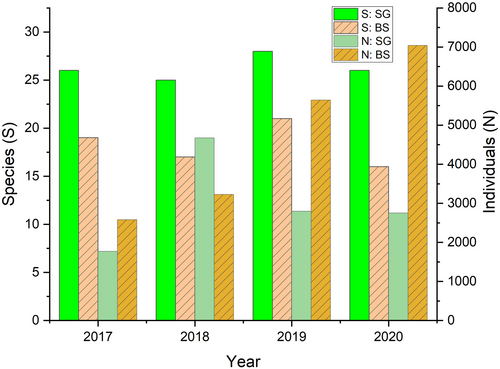
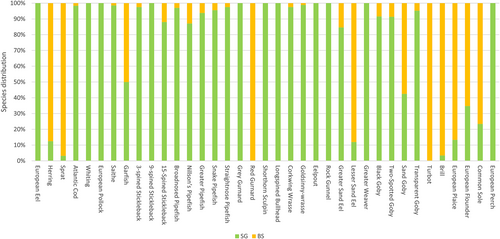
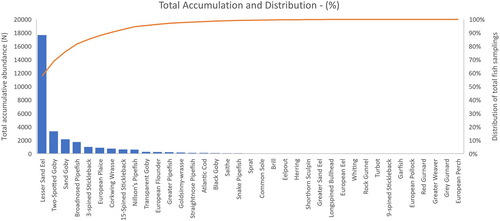
3.3 Fish species distribution and growth by coastal habitat
The Atlantic cod generally showed a slight increase in abundance over the 4-year period (Figure 6, Figure S3, Table S1); however, the increase was not significant (One-Way ANOVA; F = 2.61; p > .05). Very few Atlantic cod were found on the bare sediment, but several in the seagrass meadow (Figures 4 and 6). In 2018, however, no cod was caught at all, whereas the highest abundance was observed in the following year, that is 2019.
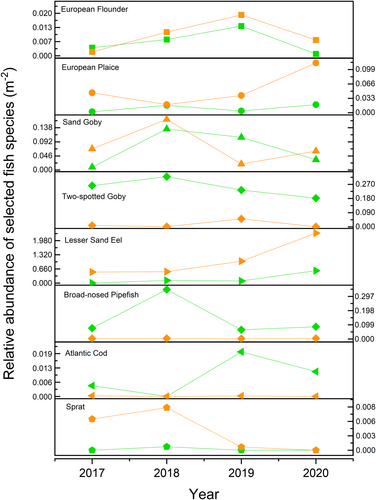
The broadnosed pipefish showed no significant change over the investigated time period (One-Way ANOVA; F = 0.15; p > .05), although a slight decrease in numbers was found (Figure 6, Figure S3, Table S1). That includes both habitats and the total number of individuals. However, generally, they were highly abundant in our samples (Figure 5) and were mainly found in the seagrass meadow (Figures 4 and 6), with significantly higher abundance in 2018 (One-Way ANOVA; F = 4.87; p < .05).
Two-spotted goby were also caught in relatively large numbers (Figure 5), especially in the seagrass meadow (Figures 4 and 6). They showed a tendency towards a slight decline (Figure 6, Figure S3, Table S1), but this was not significant (One-Way ANOVA; Ftotal = 14.35; p > .05). Although only a few were found in 2020, they were quite abundant in 2017, 2018 and 2019 (One-Way ANOVA; F = 0.37; p > .05).
Sprat was only caught occasionally (Figure 6, Figure S2); some were found in 2017 and 2018, only 3 in 2019 and none in 2020 (Figure 6, Figure S3, Table S1; One-Way ANOVA; F = 0.51; p > .05). However, this decline was not significant with regards to total numbers (One-Way ANOVA; F = 2.76; p > .05). Sprat were mostly abundant in the adjacent bare sediment (Figures 4 and 6), and here they showed a significant decline over the sampling years (One-Way ANOVA; F = 21.27; p < .05).
European plaice showed an increase in abundance (Figure 6, Figure S3, Table S1), both in total abundance and by habitat type. Over 300 individuals were found in 2020, and the increase was a general trend, with a slight decline from 2017 to 2018, followed by a relatively steep increase in numbers, which was, however, non-significant (One-Way ANOVA; Ftotal = 3.53; FBS = 2.08; p > .05). European plaice were mostly found in the adjacent bare sediment (Figures 4 and 6).
Lesser sand eel showed a steep increase in numbers for both habitat types (Figure 6, Figure S3, Table S1), both in the total number of individuals and especially in their abundance on the bare sediment, which was significant (One-Way ANOVA; Ftotal = 36.54, FBS = 26.25; p < .05). No lesser sand eels were found in the seagrass hauls from 2017; however, in 2018, 2019 and 2020, results showed a quite large increase in their relative abundance, with none of the years showing a decline (Figure 6, Figure S3, Table S1). On the bare sediment, the increase was obvious, with numbers increasing from around 2000 in 2017 to almost 8000 individuals in 2020. The lesser sand eel contributed to a large part of the total individuals sampled (about 60%; Figure 5) and was most abundant in the adjacent bare sediment (Figures 4 and 6).
Sand goby generally showed a slight decline in abundance over the investigated years (Figure 6, Figure S3, Table S1), both overall and on the bare sediment. However, with an increase in numbers in 2018 as compared to the other years (Figure 6). In seagrass, on the other hand, they exhibited a slight increase in numbers, but none of the findings were significant (One-Way ANOVA; p > .05). Sand Gobies were more abundant on bare sediment than in the seagrass meadow (Figures 4 and 6), except for 2019, where we observed higher relative abundance in the seagrass meadow.
European flounder showed a bell-shaped curve of abundance over the sampling years, with total numbers varying from 18 in 2017, to 148 in 2019 and back to 22 again in 2020 (Figure 6, Figure S3, Table S1; One-Way ANOVA; F = 2.32; p = .09). However, overall, they showed a slight increase in numbers, especially on the bare sediment (Figure 6), which was not significant (One-Way ANOVA; F = 0.07; p > .05). European Flounder was mostly found on the adjacent bare sediment, but about 35% were found in the seagrass hauls.
3.4 Fish diversity in the seagrass and bare sediment area
Biodiversity measures showed a 2–4-fold higher fish biodiversity in the seagrass meadow as compared to the adjacent bare sediment (Figure 7). The Shannon-Wiener index, or species richness, was generally much higher in seagrass meadows than on the bare sediment (Figure 7; p < .05); this accounts for all hauls, sampling years and total abundance (Figure 7, Table S3). All logged fish data showed that there were more fish species in seagrass than on sand. However, there was not a significant change over the years based on regression analysis (One-Way ANOVA; F = 0.07; p > .05). All logged fish data showed a lower Pilou's evenness on sand than in seagrass meadows (Figure 7; p > .05), and regression analysis even showed a significant decline in evenness on bare sediment over the 4 sampling years (Figure S5; One-Way ANOVA; F = 35.13; p < .05).
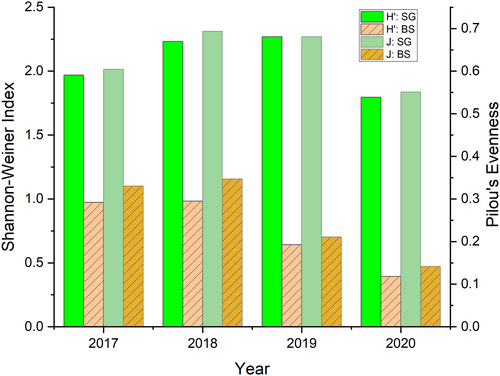
3.5 Comparison of fish species composition between coastal habitats
Bray-Curtis Similarity analysis was also performed on the total number of individuals, comparing the sampling years and the habitat types (Figure 8). The results showed a clear difference between the seagrass (SG) and bare sediment (BS) plots, with relatively increased dissimilarity in species abundance in the seagrass fish data when evaluating over the four-year sampling period (Figure 8). The bare sediment had a higher relative similarity in species abundance between the sampling years, with grouping of data by the years 2017 and 2018, and by 2019 and 2020 (Figure 8). In the seagrass meadow, the earliest of our included data in 2017 showed a higher similarity to 2019 than in 2018 and 2020. Seagrass fish data from 2020 had the highest resemblance to the samples from the bare sediment. In general, fish data from 2020 in seagrass meadows had lower resemblance to the other sampling years in seagrass, which could in part be due to the incomplete sampling during the COVID-19 pandemic.
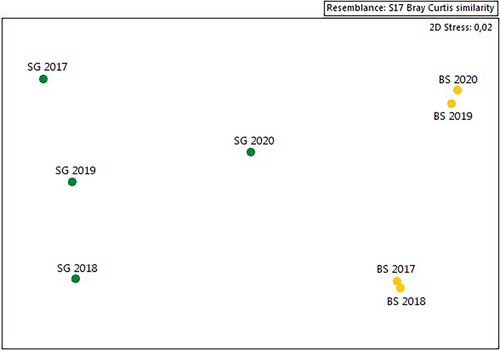
4 DISCUSSION
Our results showed that seagrass meadows, as compared with the adjacent bare sediment, are a very important habitat for the juvenile stage of the Atlantic cod population in Øresund (here, determined as having a standard length of <30 cm), as well as for the two-spotted goby, the broadnosed pipefish, the saithe, the sticklebacks and the European eel. The adjacent bare sediment, on the other hand, is an important habitat e.g. for lesser sand eel, European plaice and sprat. Seagrass meadows are also very important for the marine biodiversity in Øresund, with an about 2–4-fold higher Shannon-Wiener biodiversity Index and Pilou's evenness as compared to bare sediment in the investigated years (2017–2020), where the seagrass bed hosted ~35% more fish species than the adjacent bare sediment.
4.1 Effects of physical and chemical water-column parameters on fish abundance and assemblages
CTD profiles showed the highest mean water temperatures and the lowest water column oxygen saturations in 2017 and 2018; thus, correlating with the summer of 2018 being recorded as one of the hottest European summers ever measured by the Copernicus Climate Change Service (i.e., European State of the Climate, 2018). Generally, the water in Øresund and thereby Kronborg Bay was quite clear (i.e., low chlorophyll fluorescence), and turbidity was more dependent on wind and wave conditions being able to stir up sediment and algae from the bottom. Salinity was highly variable depending on whether the water input originates from Kattegat (bringing in more salty water) or from the Baltic Sea (bringing in more brackisk water). However, the water in Kronborg Bay over the 4 years of sampling was generally rather brackish. A clear indicator of the brackish water in the bay was the finding of a Perch in 2018, which normally is regarded as a freshwater species but can also be quite abundant in brackish water (Christensen et al., 2021). The measured water-column oxygen saturation in the bay showed only small differences in the saturation levels between the sampling years and from 100% air saturation (i.e., atmospheric equilibrium of ~20.6 kPa; Table 2). Therefore, oxygen deficiency did not seem to be an important factor in the larger differences in the recorded fish assemblages between sampling years. Possible temperature effects on the fish assemblages in Kronborg Bay include that no Atlantic cod were found in 2018 (i.e., compared to 14–75 individuals in the seagrass meadow in the other sampling years), which might be related to the extremely high summer temperatures that year. At the same time, we sampled many of the other fish species that also really thrive in seagrass meadows as actual specialists, for example two-spotted goby and Broadnosed Pipefish. Findings also showed a high abundance of all the other Pipefish species in 2018, especially in the seagrass meadow, which indicates higher tolerance to increasing temperatures. The sea stickleback abundance was lower in 2018 than in the other years, while the three-spined stickleback seemed to thrive quite well in the warmer waters, as many more were found in both habitats in 2018. The three-spined stickleback is also normally regarded as a species with a quite high temperature tolerance (Li & Kültz, 2020) and is common in the summer months along piers and beaches, but they prefer a structured habitat and are not as common on large areas of bare sediment (Carl & Møller, 2019; Notes S1). The corkwing wrasse and goldsinny wrasse also showed higher abundance in 2018 than in the other sampling years, especially in the seagrass meadow. Both species are typical for this type of environment, as they prefer a structured habitat and, at the same time, have quite high temperature tolerance (Carl & Møller, 2019; Notes S1). On the adjacent bare sediment, a small decrease in the number of European plaice may also be a sign of the relatively high summer temperatures in 2018, as they normally prefer colder and deeper water (Carl & Møller, 2019; Notes S1). Most of the European plaice caught near the coast from May to September were in the juvenile stage, which is very tolerant to high temperatures as compared to the adult stage. However, this trend was followed by an increase in the European plaice population over the sampling period, which could be a positive sign for the general population in Øresund. The sand goby was also relatively highly abundant in 2018, especially on the adjacent bare sediment.
4.2 Fish abundance and diversity: Comparison between coastal habitats
The fish populations generally differed between the seagrass meadow and the bare sediment area in their diversity, abundance, composition and richness, with higher biodiversity and numbers of fish species recorded in the seagrass meadow as compared to the adjacent bare sediment (i.e., Shannon's diversity index H´ of ~2, which is similar to what has previously been shown for Dalby Bay, Denmark; Thormar et al., 2016). This highlights the importance of the seagrass ecosystem for supporting local fish biodiversity and fisheries production, an ecosystem service provided globally by seagrass ecosystems, as supported by several previous studies (e.g., Bertelli & Unsworth, 2014; Duffy, 2006; Orth et al., 1984).
The lesser sand eel was highly abundant in the bare sediment of Kronborg Bay over the sampling years, which is interesting as it represents an important food source for especially juvenile Atlantic cods (~19%; Rindorf et al., 2012). In total, they represented over half of the over 30,000 total individuals included in this study. With the locally increasing lesser sand eel population, we would expect a slight progress in some of the larger predatory fish, following the large schools of fish into the Øresund in the spring months (see e.g., total numbers on all species in Figure 5, Figure S2, Table S1). The many lesser sand eels found in the study area, when looking at the individual level, explains why the bare sediment holds more individuals. However, if they were excluded, this would not be the case. The increase in lesser sand eel abundance on bare sediment was thus the main reason for the decrease in Evenness over the sampling period, as well as the slight decrease in species richness.
Over the 4-year time period, there were also some rare guests in the fish catchments, including fish species like brill and turbot on bare sediment (often caught in the juvenile stage: ~5–15 cm). Turbot is quite common in all inner Danish waters and on sandy sediment during the juvenile stage, but prefers sediment with larger grain sizes than found in Kronborg Bay when in the adult stage (Carl & Møller, 2019; Notes S1). The relative low amount of caught brill may be explained by their sensitivity to lower salinities (Carl & Møller, 2019; Notes S1). Herring was also only sampled in low numbers in Kronborg Bay and mainly on bare sediment, as well as, only a few Gurnards (both habitats) and Greater Weavers (only in seagrass) were found over the years. The European Eel was found only in the seagrass meadow, a species completely dependent on hiding in an environment with some degree of three-dimensional structure (Carl & Møller, 2019; Notes S1). The European eel population is in decline globally, however, with some local variation in abundances (Carl & Møller, 2019; Notes S1). The seagrass meadows in Øresund might therefore help mitigate this potential decline in the local eel population.
Biodiversity measures showed that the seagrass meadow holds more species than the adjacent bare sediment, which is comparable to a study performed by Bertelli and Unsworth (2014) in Wales, UK. They also found that the Atlantic cod basically only inhabits the seagrass meadow and rarely expands to bare sediment areas. Similar to our study, they found plaice and sand goby to be quite abundant in the seine hauls on bare sediment; however, species like brill and saithe were rare in our samplings in comparison. Our study, on the other hand, showed that the bare sediment holds more fish in total (driven by the high abundance of lesser sand eels as explained above) than the seagrass meadow, whereas the seagrass meadows hold more fish species, including several fish species of commercial interest. This clearly shows the importance of healthy and productive seagrass meadows as a habitat for fish diversity and fish stocks. This is further supported by a study by Unsworth et al. (2010) that estimated the importance of seagrass meadows for subsistence-based fishing. The study was performed in Indonesia, but it still shows the local value of seagrass meadows, even on a larger scale, with great importance for larger-scale fishing. Furthermore, in a relatively new study from Zanzibar in Tanzania, Jones et al. (2021) found a positive correlation between the fish abundance and the leaf lengths and the number of shoots of seagrass. They also discovered that the healthier the seagrass is and the larger the area it covers, the higher the fish richness. This underscores the importance of healthy and productive seagrass meadows for supporting local fish stocks (Jänes et al., 2020; Nordlund et al., 2010, 2018).
The fact that we only found the Atlantic cod in the seagrass meadow is a strong argument for future conservation efforts. Even some of the other fish, like the European plaice, seemed to thrive in the seagrass bed, confirming the findings of Bertelli and Unsworth (2014). The assumption is that the seagrass meadow has a healthy spillover effect onto the adjacent bare sediment, so that the whole Kronborg Bay benefits from the presence of seagrass. The Atlantic cod has declined since the 1980s (based on total catches; ICES, 2021), and although the Atlantic cod is not declared endangered on the IUCN red list of threatened species yet, the tendency is quite clear all over the North Atlantic region (Lilley & Unsworth, 2014). Seagrass meadows are not the only habitat for the Atlantic cod, and near-coastal kelp forests and stone reefs have comparable traits in terms of habitat complexity and suitability for Cod (Borg et al., 1997; Gotceitas & Brown, 1993). The 3-dimensional structure leaves places for hiding for the juvenile Cod fish themselves and harbours many other animals, some of which are very important prey for the larger fish (Bertelli & Unsworth, 2014). When comparing kelp and seagrass ecosystems, results show that, at least over the period where the seagrasses have higher levels of production, the fish abundance can clearly compete with that found in kelp areas (Furness & Unsworth, 2020). Moreover, the fact that seagrasses often inhabit more sandy areas than kelp, seagrass beds can support local fish stocks where kelp is not as abundant; many kelp species also require higher salinity than Z. marina (Barboza et al., 2019; Salo et al., 2014).
Seagrass habitat restoration is now increasingly employed to improve the coastal marine environment globally (Unsworth, McKenzie, et al., 2019; Valdez et al., 2020). Besides stimulating fish biodiversity, seagrasses also support other ecosystem services such as carbon and nutrient retention and coastal protection (Oreska et al., 2021). While seagrass declines over the past century at global- (Waycott et al., 2009), European- (de los Santos et al., 2019) and Danish (Krause-Jensen et al., 2021) scales have likely hampered fish stocks and general ecosystem functioning (Burkholder et al., 2007; Krause-Jensen et al., 2021; Larkum et al., 2018), protection and restoration of meadows may to some extent help recover these important ecosystem services (Orth et al., 2020; Unsworth, McKenzie, et al., 2019; Unsworth, Nordlund, et al., 2019; Valdez et al., 2020).
5 CONCLUSIONS
In conclusion, we found that seagrass meadows in Øresund can support marine biodiversity, both with regard to species richness and evenness, as compared to a neighbouring sandy habitat. Our data also indicate that seagrass meadows can be important for the Atlantic cod population in Øresund and that some of the other key fish species, like plaice, lesser sand eel and two-spotted goby, are quite abundant in their respective coastal habitats. To the best of our knowledge, this study represents the first quantitative study in Danish waters that compares fish assemblages in a seagrass meadow with an adjacent bare sediment area over a multi-year sampling period. Finally, similarity measures showed a grouping of the years, especially on the bare sediment, with high resemblance between the respective colder years 2019 and 2020, as well as between the relative hotter years 2017 and 2018. As the lesser sand eel is thriving on the sandy areas next to the eelgrass meadows in Øresund, further studies could explore how this may affect predators like the juvenile Atlantic cod.
AUTHOR CONTRIBUTIONS
KEB, MH and JPJ designed the experiment. MH and JPJ gathered the data. SLO processed the data with help from KEB. SLO, MK and KEB analysed the data. SLO wrote the manuscript with editorial help from MK and KEB. All authors have given their approval to the final version of the manuscript.
ACKNOWLEDGEMENTS
We thank all the Citizens scientists that have been involved in this project (e.g., Espergærde Gymnasium & HF, Frederiksborg Gymnasium & HF, Gentofte HF, Helsingør Gymnasium, Rungsted Gymnasium, Rødovre Gymnasium, Stenhus Gymnasium and Virum Gymnasium), as well as animal keepers Kristian Vedel Christensen and Andreas Kjær (The Øresund Aquarium), for helping with fish sampling and identification over the 4-year study period. Emil Aputsiaq Flindt Christensen and Hasna Akther are thanked for their preliminary work and thoughts on fish datasets. Jens Erik Nybo Larsen is thanked for helping with collecting the CTD profiles and for assisting with the data processing. The project was funded by grants from the Carlsberg Foundation (KEB: CF16-0899) and the Villum Foundation (KEB: 00028156).
CONFLICT OF INTEREST STATEMENT
There are no conflicts of interests in this study.
Open Research
DATA AVAILABILITY STATEMENT
All data supporting the results reported in this manuscript are available in the manuscript and the supporting information.



